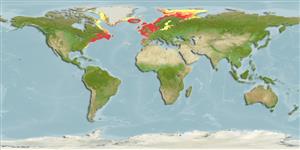Common names from other countries
分类 / Names
俗名 | 同种异名 | Catalog of Fishes(属, 种) | ITIS | CoL | WoRMS | Cloffa
Teleostei >
Clupeiformes (Herrings) >
Clupeidae (Herrings, shads, sardines, menhadens)
Etymology: Clupea: Latin, clupea = sardine, derived from Clupeus = shield; doubtless a reference to the scales covering the body of the fish + Greek, odous = teeth (Ref. 45335).
More on author: Linnaeus.
Issue
The subspecies were not characterized well enough, that unless there is more evidence presented, Clupea harengus should be considered as one species with several known populations (S.Kullander, pers.comm. 07/09).
Environment: milieu / climate zone / depth range / distribution range
生态学
海洋; 半咸淡水 底中水层性; 海洋洄游的 (Ref. 51243); 深度上下限 0 - 364 m (Ref. 58426), usually 0 - 200 m (Ref. 6683). 溫帶; 1°C - 18°C (Ref. 188); 80°N - 33°N, 95°W - 70°E
North Atlantic: in the west, it ranges from southwestern Greenland and Labrador southward to South Carolina, USA. In the east, it ranges from Iceland and southern Greenland southward to the northern Bay of Biscay and eastward to Spitsbergen and Novaya Zemlya in Russia, including the Baltic Sea (Ref. 188).
北大西洋: 比斯開灣北部向北至冰島與格陵蘭南部,向東至斯匹次卑爾根群島與新地島,包括波羅的海; 格陵蘭西南方與拉布拉多向南至南卡羅萊那州。
Length at first maturity / 大小 / 重量 / 年龄
Maturity: Lm 16.7 range ? - ? cm
Max length : 45.0 cm SL 雄鱼/尚未辨别雌雄; (Ref. 37032); common length : 30.0 cm SL 雄鱼/尚未辨别雌雄; (Ref. 37032); 最大体重: 1.1 kg (Ref. 6114); 最大年龄: 25 年 (Ref. 89560)
背棘 (总数) : 0; 背的软条 (总数) : 13 - 21; 臀棘: 0; 臀鳍软条: 12 - 23; 脊椎骨: 51 - 60. Slender fish with a round belly. Scutes without prominent keel; 12 to 16 post-pelvic scutes (Ref. 188). No median notch in upper jaw; operculum without radiating bony striae; the posterior border of its gill opening is evenly rounded. It is blue to greenish-blue dorsally, becoming silvery ventrally. No distinctive dark spots on the body or fins (Ref. 188).
没有突出的龙骨脊的鳞甲; 在上颌中的没有中央的凹槽; 没有放射状骨质陷纹的鳃盖; 鳃裂的后部边缘均匀地圆的; 没有在身体或鳍上的特殊的深色斑点; 12 到 16个在腹鳍之后的鳞甲.(参考文献 188) 银色的, 藉由蓝色或蓝绿色的背面。 细长的身体.(参考文献 7251)
Herring schools move between spawning and wintering grounds in coastal areas and feeding grounds in open water by following migration patterns learned from earlier year classes (Ref. 88171). Juveniles (up to 2 years) shoal close inshore, while adults are found more offshore (Ref. 6683). Adults spend the day in deeper water, but rise to shallower water at night (Ref. 89562). Light is an important factor in controlling their vertical distribution. A facultative zooplanktivorous filter-feeder, i.e., it can switch to filter-feeding if the food density and particle size are appropriate (Ref. 28664). Feed mainly on copepods finding food by visual sense. Herring schools often attract predators such as fish, birds, and marine mammals (Ref. 89563). Schooling, silvery sides, excellent hearing (capable of detecting frequencies between 30-4,000 Hz , Refs. 89391, 89564, 89566), and very fast escape response act as anti-predator devices (Ref. 28664). The most important races in the East Atlantic are the winter-spawning Norwegian and Icelandic herring, the autumn spawning Icelandic and North Sea herring and the Baltic Sea herring. Utilized fresh, dried or salted, smoked, canned and frozen; can be fried, broiled, microwaved and baked (Ref. 9988).
群游于沿岸水域, 与复合食性而且生殖回游 , 时间点与范围与在形态学的基础上是可认识的约略明显的比赛互有关连。 在第一个年中吃小的浮游性桡脚类的动物, 其后主要捕食桡足类。 一个官能性嗜食浮游动物的滤食动物,也就是, 如果食物密度与粒子大小很适当,它能转变成滤食性。 (参考文献 28664) 度过白天在深水中, 但是上升到水面在晚上。 他们经由视觉发现他们的食物。 进食与成长在冬天期间非常低。 他们能被分开成一些不同的品系与比赛。 在大西洋东部的最重要的比赛是冬季产卵的挪威与冰岛的鲱鱼, 产卵冰島與北海鯡魚與波羅的海鯡魚的秋天。 在一個 3-9 年的年齡時性成熟。 (參考文獻 35388) 至少一個族群在任何的一個月的每年中產卵。 卵在底部上生產。 群游性又銀色的側邊,優良的聽證會與很快速的逃亡回應擔任反掠食者裝置。 (參考文獻 28664) 在金氏世界記錄, 如最很多的魚 (參考文獻 6472), 但是在 1990 年廣泛地捕撈過度.(參考文獻 28644) 生鮮使用, 乾燥或鹽醃, 煙燻, 罐裝及冷凍; 能被油炸, 火烤, 微波而且燒烤。 (參考文獻 9988) 光是在控制他們的垂直分布方面重要的因素。 條蟲仔魚與吸蟲時常在消化道發現如寄生蟲。 (參考文獻 37032) 這種的泰晤士河-死水鯡魚 driftnet 漁場已經被檢定藉由海洋的總管職務會議 (http://www.msc.org/) 當管理良好且族群能維持。
The herring matures between 2-9 years (Refs. 35388, 82767, 89571). Herring populations are known to use traditional spawning grounds, many of which are along shallow coastal areas (15-40 m depth) or on offshore banks down to 200 m (Refs. 6684, 89572). Spawning usually occurs on gravel or rock bottoms, with the exception of Baltic populations which show a preference for shallow (less than 10 m depth) seaweed beds (Refs. 89520, 89572). Each population spawns only once a year over a relatively short time period (Ref. 89573). At least one population is spawning in any one month of the year, each having a different spawning time and place. The herring is a demersal spawner that releases a ribbon of sticky eggs that sink to the sea bed (Ref. 89574) and adhere to the substrate. The eggs released by a spawning population may be several layers thick which may deprive eggs in the bottom layers of oxygen, causing egg mortality (Ref. 89563). Although higher fecundities were reported earlier (e.g. Ref. 74523), fecundity now ranges from 10,000-60,000 eggs (Ref. 89571). Hatching may take up to 3 weeks, depending on temperature (Ref. 89571). Larvae are pelagic and drift with the current. Note: it is impossible to summarize briefly the wide range of spawning strategies of Atlantic herring; the best reviews are those of Svetovidov (Refs. 4608, 4609) for the Eastern Atlantic Ocean and Hildebrand (Ref. 4607) for the Western Atlantic Ocean.北大西洋: 比斯開灣北部向北至冰島與格陵蘭南部,向東至斯匹次卑爾根群島與新地島,包括波羅的海; 格陵蘭西南方與拉布拉多向南至南卡羅萊那州。
Whitehead, P.J.P., 1985. FAO Species Catalogue. Vol. 7. Clupeoid fishes of the world (suborder Clupeoidei). An annotated and illustrated catalogue of the herrings, sardines, pilchards, sprats, shads, anchovies and wolf-herrings. FAO Fish. Synop. 125(7/1):1-303. Rome: FAO. (Ref. 188)
CITES (Ref. 128078)
Not Evaluated
人类利用
渔业: 高经济性; 游钓鱼种: 是的
工具
特别资料
下载 XML
网络资源
Estimates based on models
Preferred temperature (Ref.
115969): 0.5 - 11.2, mean 6.6 (based on 912 cells).
Phylogenetic diversity index (Ref.
82804): PD
50 = 0.6250 [Uniqueness, from 0.5 = low to 2.0 = high].
Bayesian length-weight: a=0.00562 (0.00495 - 0.00638), b=3.09 (3.05 - 3.13), in cm Total Length, based on LWR estimates for this species (Ref.
93245).
营养阶层 (Ref.
69278): 3.4 ±0.1 se; based on diet studies.
回复力 (Ref.
120179): 中等的, 族群倍增时间最少 1.4 - 4.4年 (rm=0.1-0.5; K=0.2-0.6; tm=2-5; tmax=25; Fec=17,300-301,000).
Prior r = 0.44, 95% CL = 0.29 - 0.65, Based on 53 full stock assessments.
Fishing Vulnerability (Ref.
59153): Moderate vulnerability (41 of 100).
Climate Vulnerability (Ref.
125649): Low to moderate vulnerability (29 of 100).
